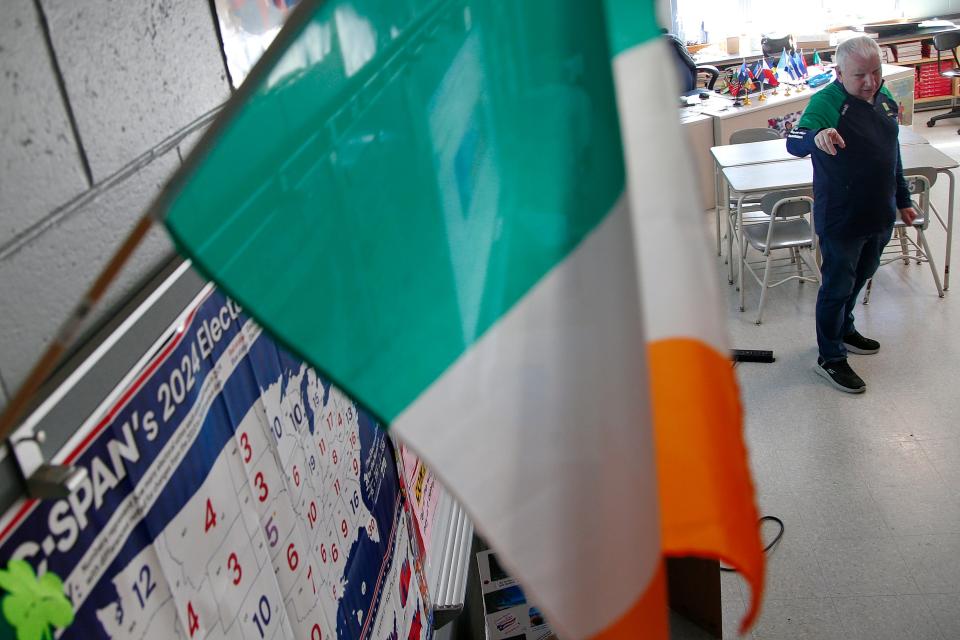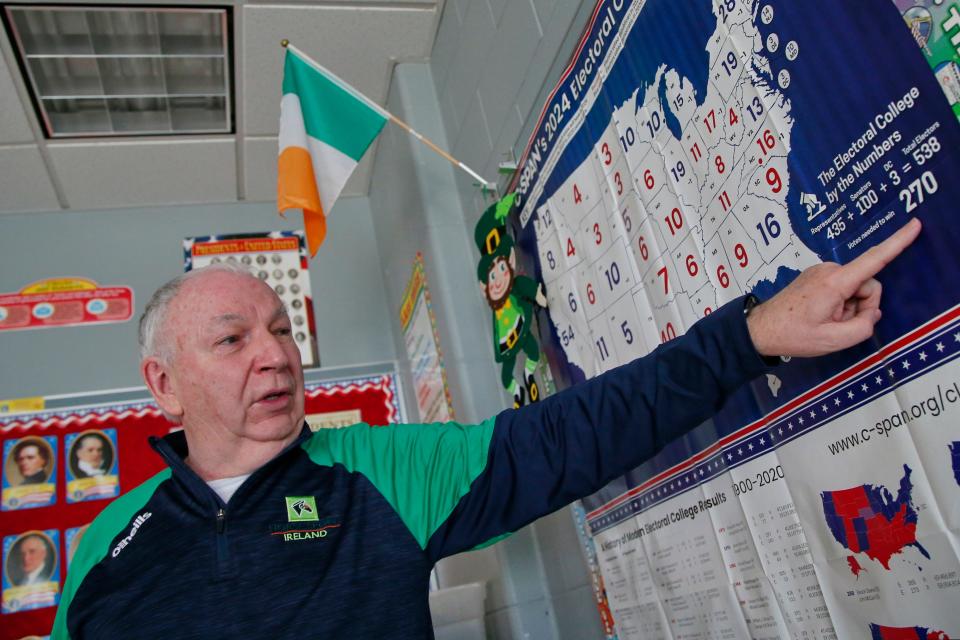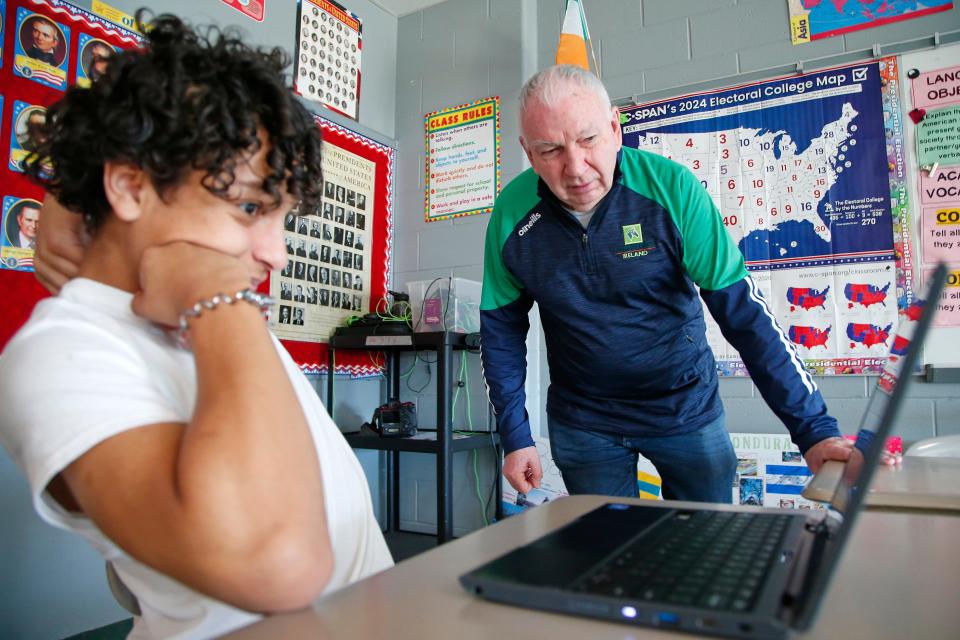A New Bedford teacher from Northern Ireland has a lot to say about St. Paddy's Day.
- Oops!Something went wrong.Please try again later.
NEW BEDFORD — St. Paddy's Day is a busy day for Christopher Donnelly.
Actually, it's more of a busy weekend for the native of Derry in Northern Ireland who came to the United States 30 years ago.
The past president and current secretary of New Bedford's Friendly Sons of St. Patrick planned to celebrate its annual gala Saturday night and then be up early on St. Patrick's Day to volunteer at the New Bedford Half Marathon, which has been stewarded by the Friendly Sons of St. Patrick since 2008.

Following the Half Marathon, he'll get together with the other volunteers for a convivial beer or two.
Teaches U.S. History at Normandin Middle School
Donnelly, who teaches social studies — including U.S. History — at Normandin Middle School, said he's also subject to more than a little homesickness as the holiday approaches and gears up.
He has three brothers and a sister who still live in Derry. He goes back for visits during the summer.
The Irish city has similarities with New Bedford, he said.
It's a port city on the the River Foyle accessing the North Atlantic. It's more of a naval port than a fishing port, though.
It's also a little larger than New Bedford, with a population in the 120,000 range.
Many of Derry's old shirt factories have been redeveloped into apartments.
Picture of JFK next to the Pope
And there's always been an affinity felt by its Catholic residents for the United States.
Growing up, Donnelly said a picture of JFK was often prominently displaced alongside one of the Pope in Derry households.
St. Patrick's Day was an important day, as well.
The 68-year-old Donnelly said that in his youth the day started in church.

A visit to the local pub would come later for those of age.
St. Patrick's Day was about the church first
"St. Patrick's Day was always first about the church, your emblem was your shamrock," he said.
Ireland's patron saint is credited with its general conversion to Christianity.
According to History.com, much of what is known about Patrick’s youth comes from his short autobiography, the "Confessio."
He was born into a well-to-do family around 386 A.D. and grew up along Great Britain’s western coast, likely in Wales, which was part of the Roman Empire at the time, according to History.com. His father was a Christian deacon and a minor Roman official, and his grandfather was a priest.
Kidnapped by Irish raiders, enslaved
Kidnapped by Irish raiders, he was held captive for six years as a slave and worked as a shepherd, according to tradition.
He became a devout Christian, and prayed up to 100 times per day, and another 100 per night, according to the tradition outlined by History.com.
He escaped and returned to Britain, but had a revelation he would return to Ireland as a missionary, which he did after 15 years of religious training, according to History.com.
Upon his return, it's said that St. Patrick's familiarity with Irish language and culture allowed him to effectively incorporate traditional rituals into his lessons of Christianity, according to History.com.
He is believed to have died on March 17, in 461 A.D.
A celebration of Irish culture
"St. Patrick is really important to people in Ireland as a celebration of our culture," Donnelly said.
"We know it's Irish. It ties us to who we are and what we are. We're proud of being Catholic, religious."
It also reinforced unity growing up in Derry during times of great sectarian violence and discrimination. "Faith makes you stronger I think," said Donnelly, who lost friends to the violence and was subjected to it himself.
It's better now, he notes.
'Drowning the shamrock'
Today's celebration of St. Patrick's Day in Ireland can also be more secular, and fun-oriented, he said.
He said shamrocks are traditionally worn in the lapel.
The fresh shamrocks stand straight up in the morning during the observance at church, but tend to droop by evening after several hours in the local pub.
"We say you drowned your shamrock," he said.
Many people in Ireland don't drink
Donnelly adds, though, that the notion that copious drinking on St. Patrick's Day is obligatory is exaggerated.
"A lot of people in Ireland don't drink," he said, many having taken an abstinence pledge denoted by a "pioneer pin" worn in the lapel.
"We're not as big drinkers as people say."
He added, "We're very social and the pubs are the natural place you go to to be social. It's a place we go for good 'craic,' which is an Irish name for fun."
It's also pronounced "crack," which led to some amusement when he hosted the late former New Bedford Mayor Frederick Kalisz Jr. on a visit to Derry.
"I remember walking down the street and I hear screaming from a friend, 'Hey Chris, do you have any craic for me?'"
He meant good news, not a sinister import.
More about having fun in the U.S.
Donnelly said the celebration of St. Patrick's in the United States is more about having fun.
And that's in keeping with the Irish temperament.
"When we go anywhere we enjoy ourselves. We don't take life too seriously. We're always good at making fun of each other," he said.
In fact, Donnelly said, "If we don't like you, we won't talk to you. We ignore you. If we like you, we're going to make fun of you. That's just the way it is. You get used to it."
Donnelly said one of the "really nice" aspects of St. Patrick's Day in the U.S. is the tradition of everyone being Irish for the day.
"I love people all dressing up in green," he said, though it can bring on a bout of homesickness.
An accent like Liam Neeson
It also tends to bring the Irish out in him. "I do get more Irish. I don't know if my accent gets worse," he joked.
That accent is reminiscent of actor Liam Neeson, by the way, who also hails from Northern Ireland.
Donnelly's immigrant journey provides a kinship with his students, he said, many of whom hail from Mexico, Guatemala, El Salvador, Honduras, and the Dominican Republic.
One 13-year-old girl was delighted to inform him that she had received her green card, or permanent resident card.
"She ran into my classroom. She was so excited to come and tell me."
Donnelly added, "I tell the students I started out with a work visa and got a green card, and became a citizen. I always tell them I'm an immigrant. I'm proud to be an immigrant. I love this country."
And he tells them, "Your parents gave up so much to come here. You need to do your best in school because your parents did the best for you. They came here for you."

Not that crazy about corned beef and cabbage
Donnelly will probably fit in a "traditional" meal of corned beef and cabbage during his busy St. Patrick's Day weekend, he said.
It's the only time he partakes of it during the year.
And that's because he's not that crazy about it.
Many an Irish-American who turned up their nose at corned beef and cabbage growing up might be heartened to learn it's never actually been an Irish favorite.
Donnelly said you'd have to search far and wide to find corned beef in Ireland, unless you went to someplace touristy.
He said you might find it in a can, like SPAM.
"That's the only way I'd ever seen corned beef in my life" before coming to the U.S.
"Now I eat it once a year. I like the cabbage and the boiled potatoes, the turnips, carrots. The corned beef is OK. It's not my favorite — it wouldn't be in my top 20."
The traditional meal's origins are Irish-American.
According to History.com, Irish immigrants living on New York City’s Lower East Side at the turn of the century substituted corned beef for Irish bacon to save money. They learned about corned beef from their Jewish neighbors.
St. Patrick's Day is about enjoyment for all
But St. Patrick's Day isn't about the food.
It's about the fun, Donnelly said.
"I think on St. Patrick's Day people are happy to feel - not just Irish people but everybody - we're going to have fun and enjoy ourselves."
This article originally appeared on Standard-Times: Irish native compares St. Paddy's Day in Northern Ireland, New Bedford

